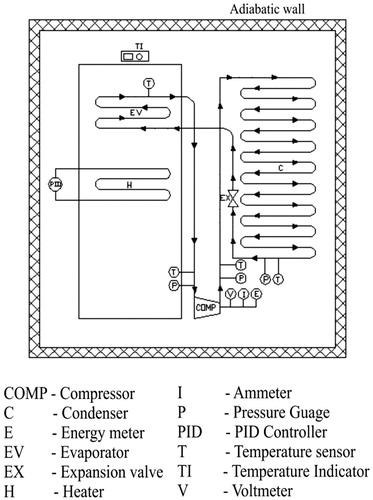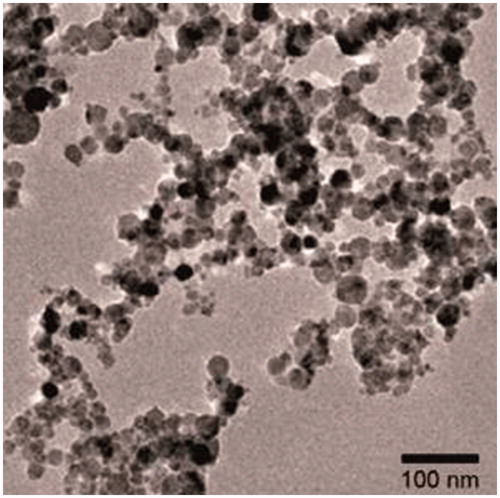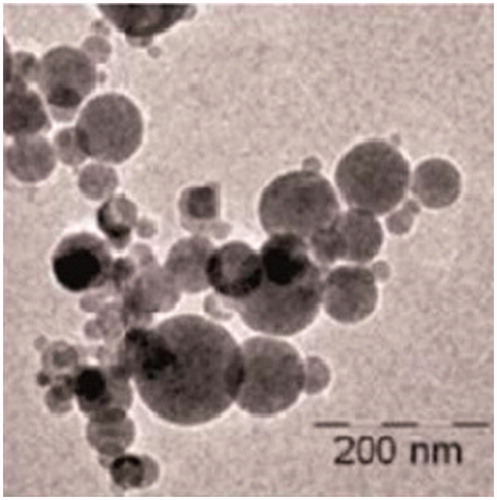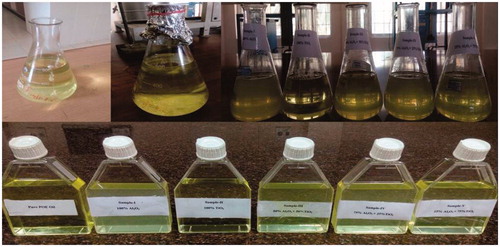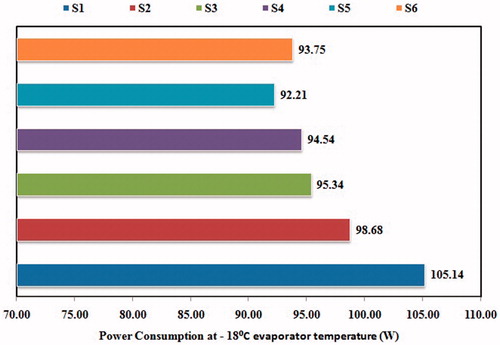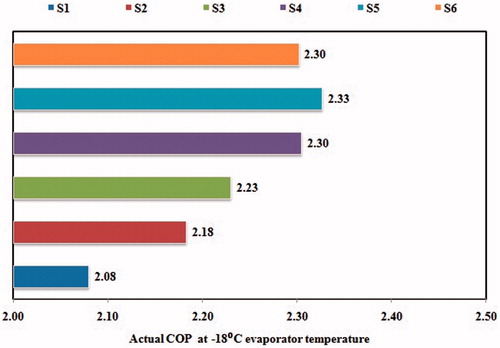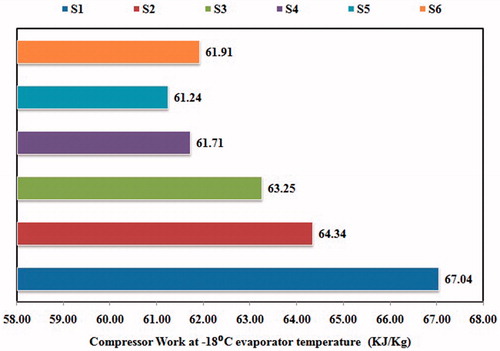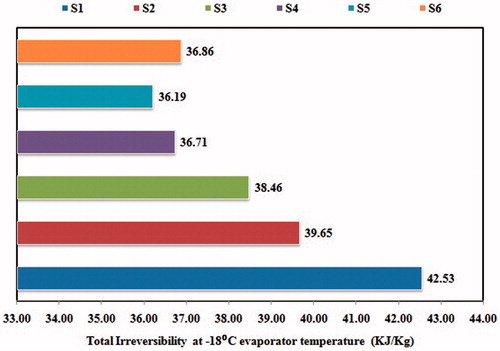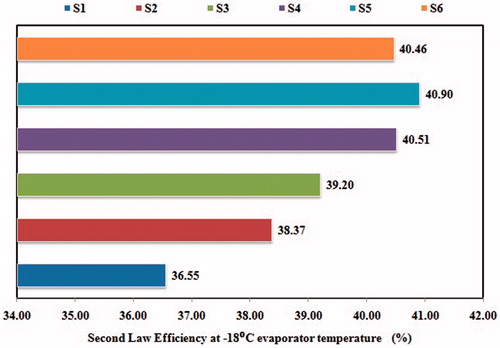 ?Mathematical formulae have been encoded as MathML and are displayed in this HTML version using MathJax in order to improve their display. Uncheck the box to turn MathJax off. This feature requires Javascript. Click on a formula to zoom.
?Mathematical formulae have been encoded as MathML and are displayed in this HTML version using MathJax in order to improve their display. Uncheck the box to turn MathJax off. This feature requires Javascript. Click on a formula to zoom.Abstract
This article presents an experimental investigation of domestic refrigerator using R134a as working fluid with different concentration of Al2O3, TiO2 nano particles and nano composite particles dispersed in polyolester (POE) oil lubricant. All the nano particles were added to the POE oil with 0.1gL−1 volume concentration. The experiments are conducted for different compositions such as R134a with POE oil, R134a with nano lubricant (Al2O3/POE oil and TiO2/POE oil) and R134a with nano composite lubricant (75% Al2O3/25% TiO2/POE oil, 50% Al2O3/50% TiO2/POE oil and 25% Al2O3/75% TiO2/POE oil). Both second law analysis and performance analysis was conducted. Analysis was based on temperature and pressure readings measured from various sensors and gauges which is attched to the system. The test conducted at −18 °C temperature in evaporator with reference to 27 °C environment state. Findings show that best performance is given by R134a with nano composite lubricant 50% Al2O3/50% TiO2/POE oil which results in lowest power consumption of 92.2 W, highest actual coefficient of performance of 2.33, lowest compressor work of 61.24 kJ/kg, lowest total irreversibility of the system of 36.19 kJ/kg and highest second law efficiency of the system of 40.9%. Thus, using this nano composite fluid mixture as lubricant in domestic refrigerator is suggested.
1. Introduction
The domestic refrigerator is a popular household appliance which transfers heat from inside to the external environment, so that the inside of refrigerator is cooled to a temperature below the room temperature. The refrigerator works with vapour compression refrigeration system. In vapour compression system, there are four major components such as Evaporator, Compressor and Condenser and Expansion valve. External energy (power) is supplied to the compressor and heat is added to the system in the evaporator, whereas in the condenser heat rejection is occurred from the system. The refrigerant enters in to the compressor as saturated vapour and is compressed to a high pressure, results in a higher temperature superheated vapour. The refrigerant heat is carried away by the surrounding air in the condenser, results in a saturated liquid. The saturated liquid refrigerant enters in to the expansion valve, results in reduction of pressure of the refrigerant. Finally the refrigerant enters in to the evaporator and draws heat from the region to be cooled. The vapour refrigerant goes back to the compressor to restart the cycle. 1,1,1,2-Tetrafluoroethane (HFC R134a) is the most widely used refrigerant in domestic refrigerator. The lubricating oil is POE oil (refrigerant oil 68) which is commonly used in refrigeration and air conditioning systems because of its premium quality.
In recent years, a possible alternative solution to improve the performance of domestic refrigerator may come from nano technology by using fluid additives like nano sized particles (1–100 nm). Choi and Eastman [Citation1], Das et al. [Citation2] and Wang and Mujumdar [Citation3] reported that nano particles are metal (or metal oxide) which enhances the heat transfer rate. Xuan and Li [Citation4] explained that due to their nano structural features, nano particles exhibit enhanced properties (mechanical, thermal, physical, chemical), phenomenon and processes than conventional materials. Kostic [Citation5] found that nano particles stay suspended much longer than micro-particles and, if below a threshold level and/or enhanced with surfactants/stabilizers; remain in suspension almost indefinitely.
Hu et al. [Citation6] found that the friction coefficient of the lubricating oil is directly related to the power consumption of the compressor. The addition of nano particles decreases the friction coefficient of the lubricating oil, which results in a decrease of energy consumption by the compressor and therefore improves the COP of the refrigerator. Henderson et al. [Citation7] found that excellent dispersion was achieved for a mixture of R-134a/polyolester with CuO nano particles and the heat transfer coefficient increased by more than 100% over the baseline R-134a/POE results. Kedzierski [Citation8] found that heat transfer of R-134a can be increased by approximately 13%, 10% and 9% for different mixture concentrations mixed with polyolester lubricant. Bobbo et al. [Citation9] revealed that a small addition of nano particles to the base lubricant does not affect the tribological properties of the base lubricant. The study showed that the POE/TiO2 mixture had the best performance compared with the pure POE.
Two common sources of irreversibility are fluid friction (causes pressure drops) and heat transfer to or from the surroundings explained by Cengel and Boles [Citation10]. An actual vapor-compression refrigeration cycle differs from the ideal one in several ways, owing mostly to the irreversibility that occurs in various components. By the addition of nano particle in lubricant improves the exergy efficiency by reducing the irreversibility of the process in domestic refrigerator. Globally 1,1,1,2-Tetrafluoroethane (HFC134a) is the most used alternative refrigerant in refrigeration equipment such as domestic refrigerators and automobile air-conditioners.
According to Bi et al. [Citation11] reported that HFC134a has been accepted as a long-term alternative refrigerant in many countries. He reported that refrigerator’s performance was better with 26.1% less energy consumption with 0.1% mass fraction of TiO2 nano particles compared to the HFC134a and POE oil system. Youbi and Bonjour [Citation12] reported that compared to POE oil, the high thermal conductivity of the nano lubricant facilitates more effective heat transfer. Kedzierski [Citation13] reported that 0.5% nano lubricant mass fraction with R134a resulted in a heat transfer enhancement relative to the heat transfer of pure R134a/polyolester. Bolaji [Citation14] studied exergy analysis of a domestic refrigerator using R134a and indicated that the highest exergy destruction occurred in compressor followed by condenser, capillary tube, evaporator and super heating coil. Wang [Citation15] reported that there is enhancement in energy efficiency by the addition of nano particles with mineral oil.
Ahmed et al. [Citation16] reported that among the components of the vapour compression systems much research showed that major part of exergy losses is occurred in the compressor. Nano fluids and nano lubricants are also used to reduce the exergy losses in the compressor indirectly. According to Saidur et al. [Citation17] reported that scientists use nano particles in refrigeration systems because of its remarkable improvement in thermo-physical and heat transfer capabilities, to enhance the efficiency and reliability of refrigeration and air conditioning systems. Subramani and Prakash [Citation18] reported that the refrigeration system with nano refrigerant works normally by reducing the power consumption to 25% compared to normal R134a/POE oil refrigeration system. Mahbubul et al. [Citation19] reported that volume fractions and temperature have significant effects over viscosity of nano fluids.
Sendilkumar and Elansezhian [Citation20] found that the Al2O3-R134a system performance was better than pure lubricant with R134a working fluid with 10.30% less energy used with 0.2% V of the concentration used and also heat transfer coefficient increases with the usage of nano Al2O3. According to Gupta et al. [Citation21] found that nano particles can be used to enhance the working fluid properties and energy efficiency of the refrigerating system. Javadi and Saidur [Citation22] showed that nano refrigerant can help to increase the performance of domestic refrigerators and reduce energy consumption. Yusof et al. [Citation23] investigated the performance of a mini box domestic refrigerator operating with and without addition of nano particles of Al2O3 in lubricant oil. The authors reported that the addition of Al2O3 nano particles to the base fluid (POE) gave better performance and reduction of power consumption. However, a nano composite particle in domestic refrigerator is very sparse.
The highlight of this work presents an effect of nano particles and nano composite particles Al2O3/TiO2 in POE oil as lubricant in domestic refrigerator. The nano particles can be added to the lubricant oil, so that the other parts of the system along with compressor will have a nano lubricant refrigerant mixture. Heat rejection and heat addition are dissimilar to different mixing of nano particles and nano composite particles with POE oil using R134a refrigerant, which cause a change in energy efficiency for the system. The performance of the refrigerator is studied based on the following factors in this paper such as power consumption of the refrigerator, coefficient of performance, compressor work, total irreversibility and second law efficiency of the compressor.
2. Materials and methods
2.1. Experimental setup
The experimental setup used in the present study is a LG domestic refrigerator of 175 L capacity. It is further modified to incorporate the sensors and compound gauges for temperature and pressure measurements. The measurements are taken at suction and discharge side of compressor, condenser, expansion valve and evaporator. Pressure gauges with a resolution of 1 kPa are used to indicate the pressure points. RTD (Resistance Temperature Detector) type PT100 temperature sensors are provided to measure the temperature at various points. One RTD PT100 washer type temperature sensor is placed inside the cabinet to measure freezer temperature. A heater is provided at the bottom of the freezer and heater temperature was controlled by a PID controller. One watt hour metre is provided to measure the energy supplied to the compressor. A voltmeter and ammeter are connected to the compressor line and heater lines separately. The schematic representation of the experimental set up is shown in the . The refrigerator specifications are listed in the and . The lubricating oil used in the compressor is polyolester oil of grade refrigeration oil 68. During the performance test, the refrigerant and the lubricant masses added to the refrigerator is strictly controlled. When each test is finished, the lubricant is discharged from the compressor and again charged with new nano particle lubricant mixtures and nano composite particles lubricant mixtures. The refrigerator was thoroughly evacuated using a vacuum pump before each trial until the system becomes clean and free of any leftover of nano particles. The accuracy of the refrigerant charge for each test is ±1 g.
Table 1. Specification of the system.
Table 2. Specification of the measuring instruments.
2.2. Preparation of POE oil, nano particle and nano composite particles mixture
The nano particles are added to the refrigeration system by first adding them in to the lubricant to make nano lubricant mixture. Then, the mixtures are put into the compressor as the lubricant. The TiO2 nano particles were provided by REinste nano ventures private limited. The TEM image for TiO2 and SEM image for Al2O3 is shown in the and . The physic-chemical data for Al2O3 and TiO2 is shown in the The lubricating oil is POE oil (refrigerant oil 68) which is commonly used in refrigeration and air conditioning systems because of its premium quality.
Table 3. Physic-chemical data for Al2O3 nano particle.
Table 4. Physic-chemical data for TiO2 nano particle.
The nano particles masses were measured in SHIMADZU AY220 with a precision of 0.1 mg as shown in the The TiO2 nano particles and Al2O3 nano particles each of 0.5 and 0.05 g mixed with 500 mL of POE oil in the ratio of 1 and 0.1 g L−1 separately. Then the mixture was kept on a magnetic stirrer with speed range of 1200 rpm at room temperature enhancing uniformity of distribution of nano particles inside the lubricant as shown in the .
Figure 4. Preparation of TiO2 and Al2O3 nano particles mixture with POE oil using digital balance and Magnetic stirrer.
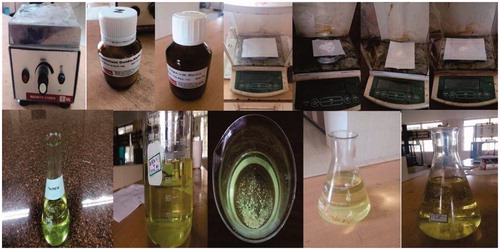
After 6 months more settlement of TiO2 and Al2O3 nano particles have observed in 1 g L−1 ie. 0.5 g/500 mL of POE oil. For TiO2 and Al2O3 in the ratio of 0.1 g L−1 ie. 0.05 g/500 mL of POE oil shows clear soluble in the POE oil. As a result nano particles mixed with POE oil in the ratio of 0.1 g L−1 have been selected for performance test. Many researchers have used this 0.1 g L−1 nano particle concentration with lubricating oil. Then six samples are prepared as per the composition shown in the .
Table 5. Composition of samples of nano and nano composite particles in POE oil.
All the samples are kept on magnetic stirrer for 48 h to enhance the uniformity of distribution of nano particles inside the lubricant. All the samples are kept for 6 months for Solubility of nano particles in lubricant to observe that the nano particles are in good dispersion with the POE oil. Agglomeration or sedimentation did not occur and the nano lubricants were stable during the observations, which could be due to the low volume concentrations of the nano particles. The photographic view of samples is shown in the .
2.3. Experimental procedure
The system was charged with refrigerant R134a and POE oil with different concentration using a charging line attached to the system. The total system is kept in an adiabatic room which is maintained at 27 °C. The experiment has been conducted on the domestic refrigerator at heater load by maintaining heater at uniform temperature of 25 °C inside the cabinet. The experiments are conducted for R134a refrigerant with six different compositions of nano and nano composite particles in POE oil as lubricants as per the . The performance of the refrigerator is first measured using R134a along with POE oil as lubricant and the readings are noted at −18 °C freezer temperature and 27 °C surrounding temperature. The experiment involves the measurement of the temperature and pressure of the compressor, condenser and evaporator. The power consumption rate of the compressor was determined by noting the time taken by the digital energy meter for 10 blinking. The observed temperatures and pressures were used to find corresponding enthalpy and entropy of the refrigerant by using REFPROP 9.0 version. The system is evacuated with the help of vacuum pump running for 3 h and charged with the help of charging system for every test samples.
2.4. Formulation for vapour compression system in domestic refrigerator
Mathematical formulation for performance analysis in different components is given below [Citation24–28]. The assumption made for the analysis is:
Steady state, steady flow condition.
Kinetic and potential energy loses are not considered.
Power consumption
Actual work input to the compressor
Reversible work
Refrigeration capacity
Second law efficiency .
Total Irreversibility , Where
= Enthalpy at compressor inlet,
= Enthalpy at compressor outlet,
= Enthalpy at freezer outlet,
= Temperature of surrounding environment, and
– Evaporator temperature.
3. Results and discussion
3.1. Power consumption
The power consumption of the refrigeration system at −18 °C evaporator temperature is shown in the It can be observed that power consumption of the samples S2, S3, S4, S5 and S6 are 6.14%, 9.32%, 10.08%, 12.29% and 10.83% respectively lower than base line sample S1. This is achieved by the addition of nano and nano composite particle in POE oil reduces the pressure ratio in the compressor. The reduction in pressure ratio reduces the compressor work and as a result the power consumption of the refrigerator has reduced. The sample S5 shows the minimum power consumption than other samples.
3.2. Actual Coefficient of performance
The actual COP of the refrigeration system at −18 °C evaporator temperature is shown in the . It can be observed that the actual COP of the samples S2, S3, S4, S5 and S6 are 4.96%, 7.23%, 10.81%, 11.89% and10.69% respectively higher than base line sample S1. This is achieved by the addition of nano and nano composite particle results in increasing the heat transfer of the refrigerant and able to increase the actual coefficient of performance of the system. The sample S5 has the highest coefficient of performance than other samples.
3.3. Compressor work
The compressor work of the refrigeration system at −18 °C evaporator temperature is shown in the It can be observed that compressor work of the samples S2, S3, S4, S5 and S6 are 4.02%, 5.65%, 7.95%, 8.65% and 7.65% respectively lower than base line sample S1.This is achieved by the addition of nano and nano composite particle reduces the discharge pressure and discharge temperature which results in reduction of work in the compressor. The sample S5 shows the minimum work of the compressor than other samples.
3.4. Total Irreversibility of the system
The total irreversibility of the refrigeration system at −18 °C evaporator temperature is shown in the It can be observed that total irreversibility of the samples S2, S3, S4, S5 and S6 are 6.77%, 9.58%, 13.68%, 14.91% and 13.33% respectively lower than base line sample S1. This is achieved by the addition of nano and nano composite particle increases the reversible work of the system with the surrounding and results in reduction of total irreversibility of the system. The sample S5 shows the minimum total irreversibility of the system than other samples.
3.5. Second law efficiency
The second law efficiency of the refrigeration system at −18 °C evaporator temperature is shown in the It can be observed that second law efficiency of the samples S2, S3, S4, S5 and S6 are 4.96%, 7.23%, 10.81%, 11.89% and 10.68% respectively higher than base line sample S1. This is achieved by the addition of nano and nano composite particle reduces the total irreversibility of the system and results in increasing the second law efficiency of the system. The sample S5 shows the maximum second law efficiency of the system than other samples.
4. Conclusion
From the experimental investigation of domestic refrigerator using R134a refrigerant with POE, nano lubricant and nano composite lubricant, the following points were concluded:
The refrigeration system shows better result for all samples of nano lubricants and nano composite lubricants S2. S3, S4, S5 and S6 with R134a when compared to base line sample S1 of normal POE oil with R134a.
The sample S5 shows the minimum power consumption which is 12.29% lower than base line sample S1. By the addition of nano composite lubricant in the compressor, there is reduction in pressure ratio which reduces the work of the compressor and results in reduction of power consumption.
The sample S5 has the highest coefficient of performance which is 11.89% higher than the base line sample S1. By the addition of nano composite lubricant, there is increase in heat transfer of the refrigerant which increases the coefficient of performance of the system.
The sample S5 has the lowest compressor work which is 8.65% lower than the base line sample S1. By the addition of nano composite lubricant in compressor, the discharge pressure and discharge temperature of the refrigerant is reduced which reduces the work of the compressor.
The sample S5 has the lowest total irreversibility of the system which is 14.91% lower than the base line sample S1. By the addition of nano composite lubricant in compressor, the reversible work of the system with surrounding increases which reduces the total irreversibility of the system.
The sample S5 has the highest second law efficiency which is 11.89% higher than the base line sample S1. By the addition of nano composite lubricant, the total irreversibility of the system is reduced which increases the second law efficiency of the system.
Thus using the refrigerant R134a along with sample S5 which is nano composite particle mixture of 50% Al2O3/50% TiO2 in POE oil as lubricant in domestic refrigerator is suggested.
Disclosure statement
No potential conflict of interest was reported by the authors.
Additional information
Notes on contributors
K. Saravanan
Saravanan K. is a research scholar in Mechanical Engineering at Anna University, Chennai. He is working as an Associate professor in Mechanical Engineering Department at Dr. Nagarathinams College of Engineering, Rasipuram, Namakkal, Tamil Nadu, India. He has authored many papers in national and international journals. He has also preseted many papers at national and international conferences. His interest covers the application of nano-particles in refrigeration using a vapour compression system.
R. Vijayan
Dr. Vijayan R. is working as a Professor and Head in Government College of Engineering, Salem, Tamil Nadu, India. He has authored many papers in national and international journals. He has also participated and presented many papers at national and international conferences. At present, he is guiding 12 research scholars. His interest covers thermal engineering, refrigeration and air conditioning areas.
References
- Choi SUS, Eastman JA. Enhancing thermal conductivity of fluids with nano particles. Paper presented at: ASME International Mechanical Engineering Congress & Exposition; 1995 Nov 12–17; San Francisco, CA.
- Das SK, Choi SUS, Patel HE. Heat transfer in nanofluids – a review. Heat Transfer Eng. 2006; 27:3–19.
- Wang XQ, Mujumdar AS. Heat transfer characteristics of nanofluids: a review. Int J Therm Sci. 2007;46:1–19.
- Xuan Y, Li Q. Investigation on convective heat transfer and flow features of nanofluids. J Heat Transfer. 2003;125:150–152.
- Kostic M. Advanced flow and heat transfer fluids. Chicago (IL): Department of Mechanical Engineering, Northern Illinois University; 2004.
- Hu ZS, Lai R, Lou F, Wang L, Chen Z, Chen G. Preparation and tribological properties of nanometer magnesium borate as lubricating oil additive. Wear. 2002;252:370–374.
- Henderson K, Park Y-G, Liu L, Jacobi AM. Flow-boiling heat transfer of R-134a-based nanofluids in a horizontal tube. Int J Heat Mass Transfer. 2010;53:944–951.
- Kedzierski MA. Effect of concentration on R134a/Al2O3 nano lubricant mixture boiling on a reentrant cavity surface. Int J Refrigeration. 2015;49:36–48.
- Bobbo S, Fedele L, Fabrizio M, Barison S, Battiston S, Pagura C. Influence of nano particles dispersion in POE oils on lubricity and R134a solubility. Int J Refrigeration. 2010;33:1180–1186.
- Cengel YA, Boles, M. Thermodynamics: engineering approach. 5th ed. New York (NY): McGraw Hill; 2006.
- Bi SS, Shi L, Zhang L. Application of nano particles in domestic refrigerators. Appl Therm Eng. 2008;28:1834–1843.
- Youbi-Idrissi M, Bonjour J. The effect of oil in refrigeration: current research issues and critical review of thermodynamic aspects. Int J Refrigeration. 2008;31:165–179.
- Kedzierski, MA. Effect of CuO nano particle concentration on R134a/Lubricant Pool Boiling heat transfer, Micro/Nano scale Heat Transfer International conference [MNHT2008-52116] Jan 6–9; Tainan, Taiwan; 2008.
- Bolaji BO. Exergetic performance of a domestic refrigerator using R12 and its alternative refrigerants. J Eng Sci Technol. 2010;5:435–446.
- Wang R, Wv Q, Wu Y. Use of nano particles to make mineral oil lubricants feasible for use in a residential Air conditioner employing hydroflourocarbons refrigerant. Energy Conversion Build. 2010;42:2111–2117.
- Ahmed JV, Saidur R, Masjuki HH. A review on exergy analysis of vapour compression refrigeration system. Renewable Sustainable Energy Rev. 2011;15:1593–1600.
- Saidur RR, Kazi, S, Hossain, M, Rahman, M, Mohammed, H. A review on the performance of nano particles suspended with refrigerants and lubricating oils in refrigeration systems. Renewable Sustainable Energy Rev. 2011;15:310–323.
- Subramani N, Prakash MJ. Experimental studies on a vapour compression system using nano refrigerants. Int J Eng Sci Technol. 2011;9:95–102.
- Mahbubul IM, Saidur R, Amalina MA. Investigation of viscosity of R123-TiO2 nano refrigerant. Int J Mech Mater Eng. 2012;7:146–151.
- Sendil Kumar D, Elansezhian R. Experimental study on Al2O3-R134a nano refrigerant in refrigeration system. Int J Modern Eng Res. 2012;2:3927–3929.
- Gupta HK, Agarwal GD, Mathur J. An overview of nanofluids: a new media towards green environment. Int J Environ Sci. 2012;3:433–440.
- Javadi F, Saidur R. (2013). Energetic, economic and environmental impacts of using nano refrigerant in domestic refrigerators in Malaysia. Energy Conversion Manage. 2013:73;335–339.
- Yusof TM, Arshad AM, Suziyana MD, Chui LG, Basrawi MF. Experimental study of a domestic refrigerator with POE – Al2O3 nano lubricant. Int J Automotive Mech Eng. 2015;11:2243–2252.
- Krishna Sabareesh R, Gobinath N, Sajith V, Das S, Sobhan CB, Application of TiO2 nano particles as a lubricant-additive for vapor compression refrigeration systems – an experimental investigation. Int J Refrigeration. 2012;35:1989–1996.
- Alawi OA, Sidik NAC, Mohammed HA, A comprehensive review of fundamentals, preparation and applications of nano refrigerants. Int Commun Heat Mass Transfer. 2014;54:81–95.
- ANSI/ASHRAE Guidelines, Guide for Engineering Analysis for Experimental dates section 6.4 ANSI/ASHRAE Guideline 2 – 1986(RA90); 1989.
- ISO 8187: Refrigerants – designation and safety classification. London: BSI; 2007.
- Ibrahim D. Refrigeration systems and applications. New York (NY): John Wiley & Sons; 2003.

